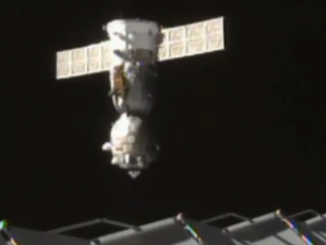
Northrop Grumman’s Cygnus spacecraft completed a roughly 40-hour journey playing catchup with the International Space Station. After launching late Sunday morning from Cape Canaveral Space Force Station on a SpaceX Falcon 9 rocket, the spacecraft arrived at the orbiting outpost Tuesday morning.
NASA astronaut Matthew Dominick used the Canadarm2 robotic arm to capture the Cygnus spacecraft at 3:11 a.m. EDT (0711 UTC) with fellow Crew-8 member and NASA astronaut Jeanette Epps serving in the backup role.After Cygnus was captured, control of Canadarm2 shifted to ground controllers to complete the berthing process on the Unity module’s Earth-facing port.
Using the Canadarm2 robotic arm, NASA astronaut @dominickmatthew captured the Cygnus spacecraft at 3:11am ET. Mission controllers will begin guiding the spacecraft in for installation to the Earth-facing port of the Unity module at 4:30am. More… https://t.co/FYZk0H5vEs pic.twitter.com/mbrgzF5hwf
— International Space Station (@Space_Station) August 6, 2024
The timing of the capture operation faced some uncertainty shortly after launch when NASA said Cygnus failed to complete the first “targeted altitude burn” or TB1, which was set for 11:44 a.m. EDT (1544 UTC), less than an hour after liftoff. In a Sunday evening blog post, the agency said that was “due to a late entry to burn sequencing.”
The update stated that a second attempt at the TB1 scheduled for 12:34 p.m. EDT (1634 UTC) that day was aborted by the spacecraft “shortly after the engine ignited due to a slightly low initial pressure state.”
In a separate blog post on Monday, NASA said that the Cygnus spacecraft was able to complete “two delta velocity burns,” allowing it to remain on track for capture Tuesday morning. It said the reason for the cancelled burns turned out to be “due to a slightly low initial pressure reading flagged by the Cygnus onboard detection system.”
“Engineers at Northrop Grumman’s mission control center in Dulles, Virginia evaluated the pressure reading, confirmed it was acceptable and re-worked the burn plan to arrive at the space station on the originally planned schedule,” a NASA spokesperson wrote, adding that “The spacecraft is in a safe trajectory and all other systems are operating normally.”
The roughly 8,200 lbs. (3720 kg.) of science and supplies will be used by the crews of Expedition 71 and 72 during their time on orbit.

Golden catch
In the run-up to the launch of the Cygnus spacecraft on Aug. 4, the Canadian Space Agency (CSA) announced that this will be the 50th so-called “cosmic catch” of a cargo ship for Canadarm2, formally the “Space Station Remote Manipulator System” (SSRMS). It’s first such operation was on Sept. 17, 2009, when it caught the Japanese Aerospace Exploration Agency’s (JAXA) HTV-1 spacecraft.
It would go on to catch a total of nine H-2 Transfer Vehicles (HTV), 20 Cygnus spacecraft and 20 Cargo Dragon spacecraft in the lead up to receiving the NG-21 vehicle.
The 17-meter-long (56 ft.) arm was built by MacDonald, Dettwiler and Associated Ltd. (MDA Space) in Ontario, Canada, and launched to the ISS during the space shuttle mission STS-100 in April 2001. The arm is still managed by MDA Space with funding from CSA.



